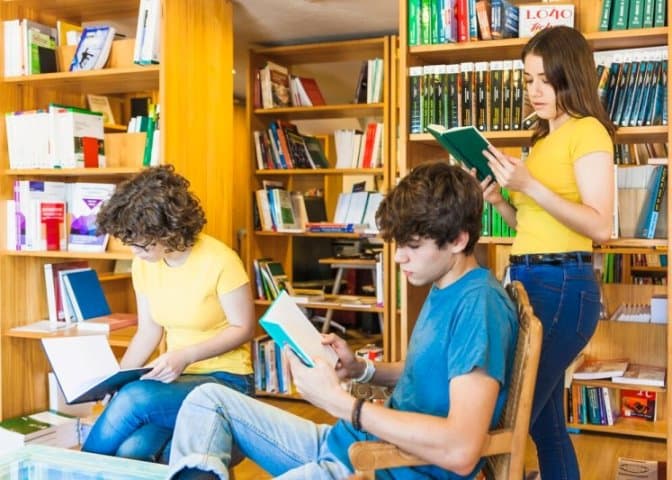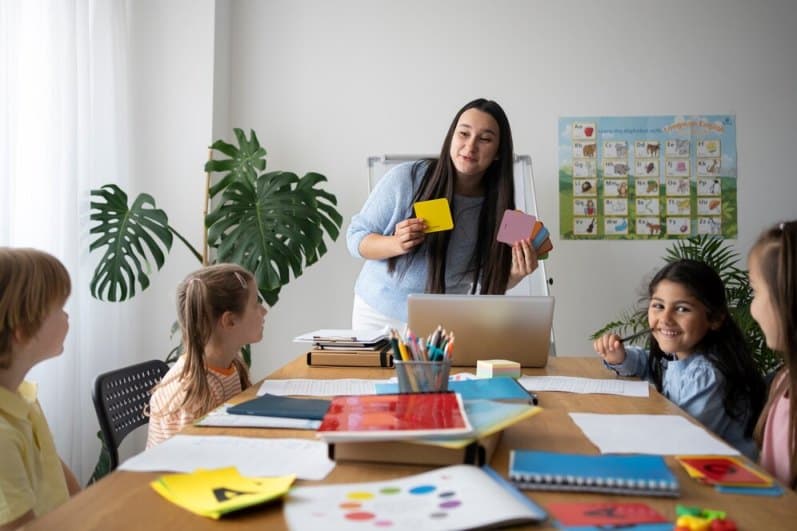Using the library actively can transform students’ study habits and research skills. With resources ranging from physical and digital books to specialized databases and multimedia materials, libraries support students in discovering high-quality, credible information that’s often unavailable on general internet searches.
Furthermore, libraries provide quiet and comfortable study spaces essential for focused work—spaces that students might struggle to find in busy home or social settings.
However, many students may overlook these benefits. Here, we outline effective strategies to inspire students to explore and take advantage of their library’s resources.
10 Strategies To Encourage Students To Use the Library
Encouraging students to use the library not only enhances their research skills but also inspires a lifelong love of learning. Here are ten effective ways to encourage students to make the most of their library.
1. Highlight the Benefits of Library Usage
One of the most impactful ways to encourage students to use the library is by clearly articulating its benefits. Many students may not realize the range of resources and services available.
Libraries provide access to physical and digital resources, including books, academic journals, multimedia materials, and specialized databases that students may not find elsewhere.
Beyond resources, libraries offer study spaces conducive to focus and productivity, a contrast to crowded cafes or noisy home environments.
Additionally, libraries often host workshops and events that enhance learning and professional development, such as resume-building sessions, research methods seminars, and guest lectures. When students understand these advantages, they are more likely to see the library as a valuable asset.
Read Also: Where to study better? Decides between your home and the library
2. Make Library Orientation a Mandatory Experience
Introducing students to the library through a structured orientation can significantly increase familiarity and usage. Library orientations are often an essential, yet underutilized, approach to engagement.
By making library orientation sessions mandatory for new students, educators and administrators ensure that every student gains firsthand experience navigating the library’s resources.
During these sessions, students can learn about library catalog systems, digital resource access, borrowing policies, and specialized research databases.
Practical demonstrations on search techniques and research methodologies can further enhance their confidence in using these resources effectively. The more comfortable students feel with the library, the more likely they are to use it regularly.
3. Partner with Faculty to Promote Library Resources
Faculty members can play a crucial role in encouraging students to utilize the library by incorporating library resources into coursework. When professors reference specific library materials for assignments or provide reading lists accessible in the library, students have a clear incentive to visit.
Collaborations between librarians and faculty can help design research assignments that rely on library resources, encouraging students to explore relevant databases, journals, and books.
Faculty could also host office hours or class meetings within the library to emphasize its role in academic life. By integrating library usage into the curriculum, faculty can make the library an indispensable tool for their students.
4. Host Engaging Workshops and Events for Students
Workshops, seminars, and events provide additional reasons for students to visit the library. Libraries can host skill-building workshops on topics like academic writing, citation management, and data analysis, which are highly beneficial for students across various fields.
Additionally, libraries can offer subject-specific research workshops led by knowledgeable librarians, helping students gain expertise in navigating specialized resources.
Events such as book clubs, guest speaker sessions, and study nights can foster a sense of community, encouraging students to view the library as more than just a study space.
Libraries could even organize competitions or challenges — such as a “library scavenger hunt” or a “reading marathon” — to engage students in fun, educational activities that simultaneously familiarize them with available resources.
5. Improve Library Accessibility and Comfort
A welcoming, comfortable library environment encourages students to make full use of the space and resources available. Updating the library with comfortable seating, ample lighting, and quiet, designated study zones can make the library a place where students want to spend time.
Spaces for individual work, group study, and technology-supported learning can also increase the library’s appeal by accommodating different needs and preferences.
To further support students, libraries can offer extended hours, particularly during exam periods, allowing more flexibility for those with busy schedules or who prefer studying in the evenings.
Providing additional services, such as online access to materials, virtual consultations with librarians, and mobile library apps, allows students to interact with library resources even if they cannot physically visit.
6. Empower Student Ambassadors to Promote Library Use
Peer influence can be a powerful motivator for encouraging library engagement. By creating a library ambassador program, libraries can enlist enthusiastic students to share their positive experiences and promote library resources within their networks.
These student ambassadors can use social media, student clubs, and campus events to raise awareness about the library’s offerings, from study spaces to specialized resources.
Additionally, ambassadors can organize informal library tours, study meet-ups, or “ask an ambassador” sessions to help other students feel comfortable navigating the library.
Students are more inclined to use and support library resources when they observe their classmates doing so. This peer-led approach not only boosts library visibility but also helps build a supportive, collaborative learning environment on campus.
7. Promote Digital Resources and Remote Access
In today’s digital era, many students may prefer accessing materials online. Libraries should emphasize the availability of e-books, online databases, and digital archives to attract students who may not otherwise consider the library.
Clear instructions on how to access these digital resources, both on-campus and remotely, can make it easier for students to use the library’s services.
Offering virtual workshops, webinars, and online tutorials on using these digital resources can further increase engagement. Students who become proficient in accessing digital resources will see the library as a crucial part of their academic toolkit, whether they are on or off campus.
8. Promote Library Resources Through Targeted Marketing
Effective marketing can make the library more visible and appealing to students. Libraries can use email newsletters, social media platforms, and campus bulletin boards to inform students about available resources, upcoming events, and research tips.
Highlighting features like a “Resource of the Week” or “Study Tip of the Month” through engaging, visually appealing posts keeps the library top of mind.
A well-organized, user-friendly library website with clear navigation and updated information also plays a crucial role in enhancing accessibility and interest. Through a variety of methods, successful marketing campaigns may influence students’ perceptions of the library as a vibrant, vital part of their academic lives.
9. Provide Incentives for Frequent Library Use
Incentives can be powerful motivators for students. Libraries could establish a reward program where students earn points for frequent visits, attending workshops, or checking out resources, with rewards such as café vouchers, study supplies, or raffle entries.
Other strategies might include offering study space reservations, priority access to new materials, or even small scholarships for students who regularly use library resources for research projects.
These incentives can create a sense of excitement around library visits, motivating students to take full advantage of what’s available.
10. Solicit Student Feedback for Continuous Improvement
Actively seeking student feedback is essential to making the library a more effective and appealing resource. Libraries can use surveys, suggestion boxes, and focus groups to gather insights from students about their experiences, needs, and any areas for improvement. This feedback can cover aspects such as resource availability, study space design, service hours, and digital accessibility.
By regularly reviewing and acting on this input, libraries can make meaningful changes that align with students’ evolving needs. When students see their suggestions being implemented, they feel a stronger connection to the library and are more likely to view it as a resource that genuinely supports their academic journey.



